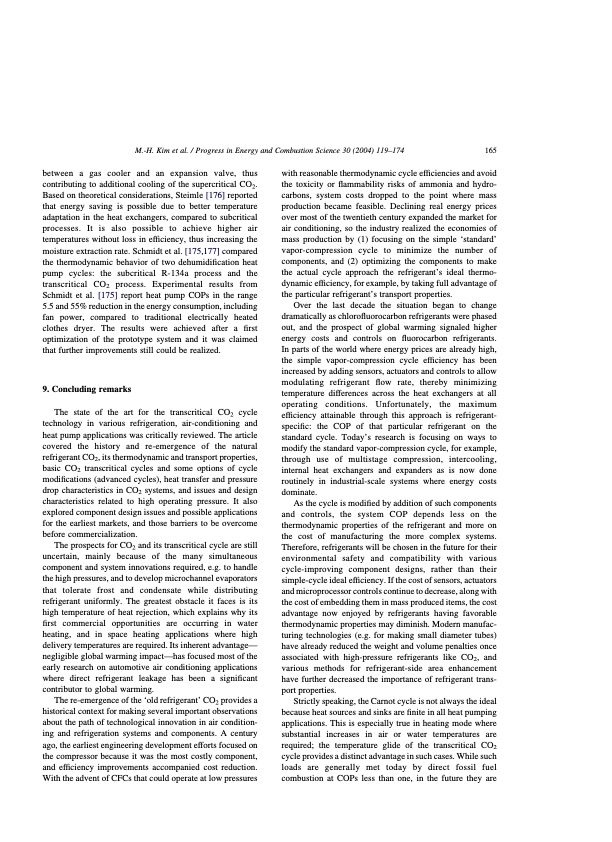
PDF Publication Title:
Text from PDF Page: 047
M.-H. Kim et al. / Progress in Energy and Combustion Science 30 (2004) 119–174 165 between a gas cooler and an expansion valve, thus contributing to additional cooling of the supercritical CO2. Based on theoretical considerations, Steimle [176] reported that energy saving is possible due to better temperature adaptation in the heat exchangers, compared to subcritical processes. It is also possible to achieve higher air temperatures without loss in efficiency, thus increasing the moisture extraction rate. Schmidt et al. [175,177] compared the thermodynamic behavior of two dehumidification heat pump cycles: the subcritical R-134a process and the transcritical CO2 process. Experimental results from Schmidt et al. [175] report heat pump COPs in the range 5.5 and 55% reduction in the energy consumption, including fan power, compared to traditional electrically heated clothes dryer. The results were achieved after a first optimization of the prototype system and it was claimed that further improvements still could be realized. 9. Concluding remarks The state of the art for the transcritical CO2 cycle technology in various refrigeration, air-conditioning and heat pump applications was critically reviewed. The article covered the history and re-emergence of the natural refrigerant CO2, its thermodynamic and transport properties, basic CO2 transcritical cycles and some options of cycle modifications (advanced cycles), heat transfer and pressure drop characteristics in CO2 systems, and issues and design characteristics related to high operating pressure. It also explored component design issues and possible applications for the earliest markets, and those barriers to be overcome before commercialization. The prospects for CO2 and its transcritical cycle are still uncertain, mainly because of the many simultaneous component and system innovations required, e.g. to handle the high pressures, and to develop microchannel evaporators that tolerate frost and condensate while distributing refrigerant uniformly. The greatest obstacle it faces is its high temperature of heat rejection, which explains why its first commercial opportunities are occurring in water heating, and in space heating applications where high delivery temperatures are required. Its inherent advantage— negligible global warming impact—has focused most of the early research on automotive air conditioning applications where direct refrigerant leakage has been a significant contributor to global warming. The re-emergence of the ‘old refrigerant’ CO2 provides a historical context for making several important observations about the path of technological innovation in air condition- ing and refrigeration systems and components. A century ago, the earliest engineering development efforts focused on the compressor because it was the most costly component, and efficiency improvements accompanied cost reduction. With the advent of CFCs that could operate at low pressures with reasonable thermodynamic cycle efficiencies and avoid the toxicity or flammability risks of ammonia and hydro- carbons, system costs dropped to the point where mass production became feasible. Declining real energy prices over most of the twentieth century expanded the market for air conditioning, so the industry realized the economies of mass production by (1) focusing on the simple ‘standard’ vapor-compression cycle to minimize the number of components, and (2) optimizing the components to make the actual cycle approach the refrigerant’s ideal thermo- dynamic efficiency, for example, by taking full advantage of the particular refrigerant’s transport properties. Over the last decade the situation began to change dramatically as chlorofluorocarbon refrigerants were phased out, and the prospect of global warming signaled higher energy costs and controls on fluorocarbon refrigerants. In parts of the world where energy prices are already high, the simple vapor-compression cycle efficiency has been increased by adding sensors, actuators and controls to allow modulating refrigerant flow rate, thereby minimizing temperature differences across the heat exchangers at all operating conditions. Unfortunately, the maximum efficiency attainable through this approach is refrigerant- specific: the COP of that particular refrigerant on the standard cycle. Today’s research is focusing on ways to modify the standard vapor-compression cycle, for example, through use of multistage compression, intercooling, internal heat exchangers and expanders as is now done routinely in industrial-scale systems where energy costs dominate. As the cycle is modified by addition of such components and controls, the system COP depends less on the thermodynamic properties of the refrigerant and more on the cost of manufacturing the more complex systems. Therefore, refrigerants will be chosen in the future for their environmental safety and compatibility with various cycle-improving component designs, rather than their simple-cycle ideal efficiency. If the cost of sensors, actuators and microprocessor controls continue to decrease, along with the cost of embedding them in mass produced items, the cost advantage now enjoyed by refrigerants having favorable thermodynamic properties may diminish. Modern manufac- turing technologies (e.g. for making small diameter tubes) have already reduced the weight and volume penalties once associated with high-pressure refrigerants like CO2, and various methods for refrigerant-side area enhancement have further decreased the importance of refrigerant trans- port properties. Strictly speaking, the Carnot cycle is not always the ideal because heat sources and sinks are finite in all heat pumping applications. This is especially true in heating mode where substantial increases in air or water temperatures are required; the temperature glide of the transcritical CO2 cycle provides a distinct advantage in such cases. While such loads are generally met today by direct fossil fuel combustion at COPs less than one, in the future they arePDF Image | CO2 Vapor Compression Systems

PDF Search Title:
CO2 Vapor Compression SystemsOriginal File Name Searched:
co2-vapor-compression-systems.pdfDIY PDF Search: Google It | Yahoo | Bing
CO2 Organic Rankine Cycle Experimenter Platform The supercritical CO2 phase change system is both a heat pump and organic rankine cycle which can be used for those purposes and as a supercritical extractor for advanced subcritical and supercritical extraction technology. Uses include producing nanoparticles, precious metal CO2 extraction, lithium battery recycling, and other applications... More Info
Heat Pumps CO2 ORC Heat Pump System Platform More Info
| CONTACT TEL: 608-238-6001 Email: greg@infinityturbine.com | RSS | AMP |